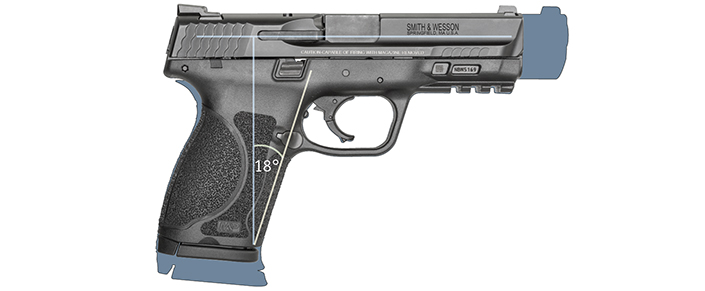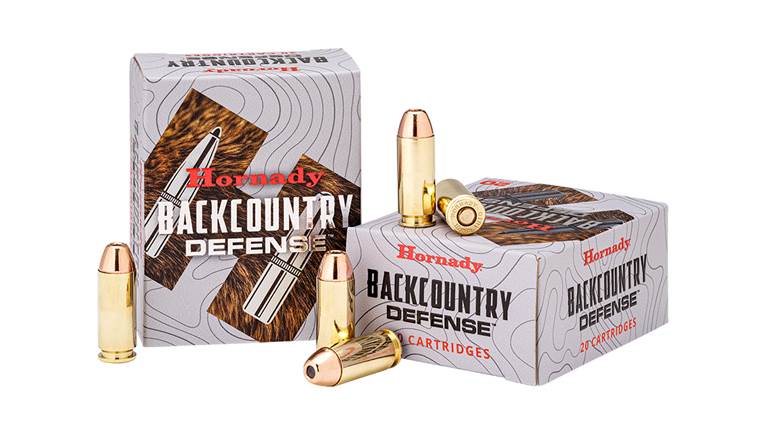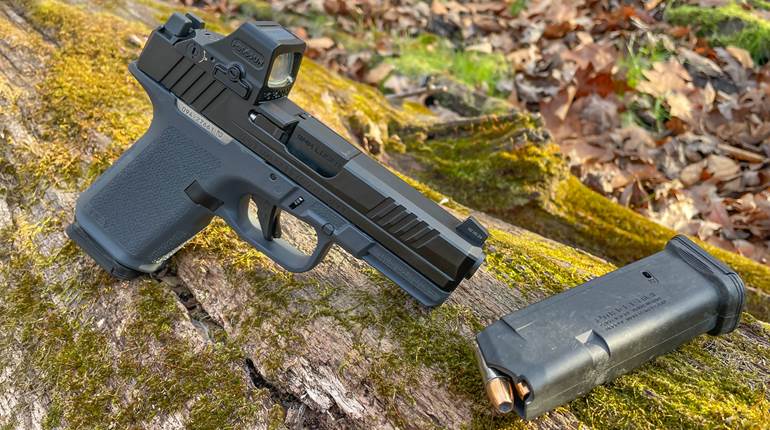
In the interest of full disclosure, I have to admit that this is one I’ve been waiting for—and I know I’m not alone. Smith & Wesson’s M&P M2.0 Compact downsizes the striker-fired, self-loading M2.0 platform to use a 4" barrel and a 15-round magazine in its 9 mm Luger configuration (a 13-round .40 S&W model is also available). It’s not a major overhaul considering the full-size models’ 4.25" or 5" tube and 17-round capacity, but the changes put an M&P model in direct competition with the Glock 19 for the first time, and that is exciting. While Glocks aren’t for everybody, the G19 has long been considered a near-perfect duty/carry crossover pistol, finding favor with gun-toting professionals and armed citizens alike thanks to its excellent shooting and concealment qualities, and the fact that it has plenty of ammunition on board. Through the years, Smith & Wesson and other manufacturers have certainly developed “competitive” models, but there has been a scarcity of 4"-barreled, 15-round 9 mm platforms, despite the merits and popularity of such a configuration. I, for one, am glad to see a serious alternative enter the category, especially one made in America by a firm that has a very long history of producing service sidearms and self-protection handguns. Iron sharpens iron—and, when it comes to fighting irons, I think competition is a boon to consumers.
Giving the gun a once-over, the M&P lineage is obvious—there are no major departures from S&W’s first generation of polymer-frame striker-fired semi-automatics, but there are some serious enhancements. The M2.0’s most prominent upgrades are the aggressive pebbled texturing pattern on the frame and the much-improved trigger system—more on those later. In terms of controls, the M2.0 retains the M&P’s bilateral slide stop/release—though the frame’s molded fencing is improved—and the reversible magazine release. And, as with all M&Ps, models are available with or without a bilateral, manual thumb safety—probably the biggest differentiating factor between the M&P and Glock platforms. Similar in appearance and function to an extended M1911 safety, the M2.0’s control has a very clear tactile and audible click when manipulated—up for safe, down for fire—and, unlike an M1911, the M&P’s slide can still be cycled with the safety on.
Prior to the M2.0 upgrades, the M&P series had some well-regarded features that have been carried on in the newer designs. The 18-degree grip angle, for one, has served Smith & Wesson well, with many shooters preferring the feel and natural pointing characteristics it provides. Likewise, Smith & Wesson was early to the game with regard to fitting the handgun to the user by providing interchangeable backstraps to adjust the grip frame’s dimensions. Its palmswell grip inserts—labeled S, M and L for small, medium and large—are easy to exchange and can noticeably improve the interface between a shooter’s hand and the firearm. Another change in the M2.0 iterations is the addition of a fourth palmswell which is labeled “ML” and splits the difference between the medium and large inserts. The process for exchanging the palmswells is unchanged: A frame tool—that also provides a lanyard loop—is housed in the bottom rear of the grip frame. Rotating the tool 90 degrees in either direction allows it to be retracted from the bottom of the gun. The frame tool serves as the locking pin for the palmswell inserts, so once it is removed the insert can be lifted up and off the frame. Then simply replace the insert with the desired size and re-install the frame tool to secure it.

The Compact model differs from the full-size M2.0s (June 2017, p. 46) in three key dimensions. First, the frame is unchanged in size and configuration from front to back, even retaining the three-slot accessory rail on the dustcover, but the grip has been chopped by about 1/2", reducing the gun’s height from 5 1/2" to right about 5". This is a critical change for two reasons: first, it enhances the concealment qualities of the gun—the butt of a pistol is often the most difficult feature to conceal beneath a cover garment. Secondly, the change necessitates the use of likewise-reduced magazines, in this case translating into two 9 mm Luger cartridges, reducing total capacity from 17 rounds down to 15 in the Compact. While looking at the magazines, it’s worth mentioning that the frames of all M2.0s feature bilateral finger scallops just above the magazine well to allow for better access and improved purchase when manual removal is necessary, particularly in the case of a malfunction. Also specific to the Compact model, Smith & Wesson includes two grip-extending magazine collars for use with full-size magazines of the appropriate chambering. It’s a thoughtful addition that allows for added-capacity reloads and a full-size grip area.
The final dimensional difference is in the barrel and slide, both of which are trimmed down compared to the full-size models to 4" and about 7", respectively (overall length is about 7 1/4", depending on the selected backstrap). The contours of the slide have been modified just a touch, but retain the same general profile as the original: scalloped cocking serrations at the rear, slimming/lightening bilateral contour cuts moving forward and angled, bilateral relief cuts at the muzzle to ease re-holstering. The M2.0’s slide features softer, beveled cuts and corners compared to earlier M&Ps, and small sections of scalloped cuts have been added near the muzzle to serve as forward cocking serrations (though a semi-circular window in the barrel shroud serves as a loaded-chamber check and provides an alternative to press-checking). The slide of the M2.0 Compact is topped by steel sights in a white, three-dot configuration. Despite being shortened, the pistol’s slide still provides for approximately 6 1/4" of sight radius.

Disassembly is unchanged from the typical M&P procedure: Remove the magazine and lock the slide to the rear, ensuring the chamber is empty. Use the frame tool to tip the sear-release lever—inside the magazine well, just below the breech face—downward. With the sear released, rotate the takedown lever clockwise and release the slide forward and off the frame. Once the slide is off the frame, the barrel and recoil spring can be removed from the slide.
With the slide removed, we can get a good look at the internal mechanisms housed within the Compact’s molded polymer frame. Two sets of steel rails guide and retain the slide—a 1" track atop the trigger housing block and a 3/8" section integral to the sear block at the rear of the frame. In terms of safeties, the M&P’s articulated trigger features a safety tab that engages the frame, stopping rearward movement of the trigger. Therefore, an intentional, full-finger press is required, and will cause the lower portion of the trigger face to hinge back, pivoting the tab upward and allowing the trigger to be pulled fully to the rear. A slide-mounted, spring-tensioned striker block retains the firing pin until it is deactivated by upward pressure from a lug that extends up from the transfer bar, and engages the block during its rearward travel. As well, guns with the manual thumb safety feature a metal blocking bar that rises into the path of the transfer bar when the safety lever is in the up position.
Returning to the trigger, the M2.0 family features a mechanism that is vastly improved over the original M&P series semi-automatics. Fans of the S&Ws often lamented the unrefined qualities and pull characteristics of the mechanism, particularly its lack of a discernible reset. When the M&P family expanded to include the Shield pistol, I noted in our review of that gun (July 2012, p. 42) that a lot of work had been done to improve the trigger, and indeed the reset was addressed and accompanied by a tactile and audible cue. The system was further refined in Performance Center models, and the results of continuous evolution are apparent in M2.0 pistols which possess, by far, the best stock M&P triggers to date. My evaluation gun exhibited less than 1/2" of effortless takeup, then just 1/16" of resistance before a crisp break. Reset comes after less than 1/4" of forward movement. Out of the box, the Compact’s trigger pull weight was 5 lbs., 13 ozs., and it only got better from there.
Range Reports
As stated at the top, the M2.0 Compact in 9 mm Luger was a gun I had been waiting for; I was excited for it. Semi-automatic pistols that are small enough to carry but large enough to train with, and enjoyable to shoot, are of particular interest to me, so the possibility of an enhanced M&P as direct competition for the Glock 19 really tripped my trigger. I also realized, though, that to truly contend with the Glock, this new M&P had to prove its reliability beyond the several hundred rounds typically required for a pistol evaluation. It had to run for thousands of rounds, with minimal maintenance. To that end, I committed to testing the Compact to at least 2,000 rounds. It was a gun I could envision myself carrying, so I wanted to make sure I could trust my life to it.
Without getting into the blow-by-blow—detailed range reports are available at americanrifleman.org under the “Gun Gear Of The Week” category—I ran the Compact hard and exceeded the 2,000-round threshold. I used a range of ammunition in testing, including more than 1,200 rounds of Aguila Ammunition (115-gr. FMJ, 115-gr. +P, 117-gr. JHP, 124-gr. FMJ and 147-gr. FMJ FP), several hundred rounds from SIG Sauer (124-gr. FMJ, 124-gr. JHP and 147-gr. JHP), and a healthy variety of other brands, bullet weights and profiles—including the ultra-light, ultra-fast 65-gr. ARX load from NovX—for the remainder. So, what did I learn?
First, the Compact ran flawlessly. There was not a single malfunction, stoppage, hiccup, rattle, flaw or failing throughout the entire course of fire. I cleaned and lubed the gun only twice during the test, once at zero rounds and again at 1,000. Examining the gun, post-testing, all the components cleaned up easily, the metal contact surfaces were polished right where they should be, and the wear was smooth and even, a sign of good fit and function.
The gun was also accurate. The results of our standard testing protocol are tabulated on p. 41, but even those impressive numbers don’t do the gun justice because they don’t convey just how well the gun points, how well the heavy texturing anchors it in the hand, or just how good the trigger really is—and how much a good trigger can aid accurate shooting.
On that note, the Compact is probably best defined in my mind by two characteristics that are now hallmarks of S&W’s M2.0 line, namely the texture and the trigger. The molded polymer frame features a very coarse, gritty texture all the way around the grip. It is without question the most aggressive factory texturing I’ve encountered, and is closer to a custom stippling job, in terms of feel, than a stock molded frame. In the hand, as long as your hands aren’t too sensitive, the texture effectively increases purchase and improves control and handling during recoil. There is one drawback, however, which is experienced when carrying the gun against bare skin, as in a concealed, inside-the-waistband holster—the grip can really rub the carrier. This effect can be mitigated with a good holster and a quality gun belt, but incidental contact is unavoidable, and can be a bit uncomfortable. Some have suggested sanding the texture down a bit, but because of how effective it is when shooting, I haven’t been able to justify doing so. Instead, I’ve just been sure to keep a T-shirt between the gun and my skin.

The second defining feature is the Compact’s trigger. It is remarkable for a striker-fired, double-action design, and a testament to how far the M&P pistols have come since their introduction in 2005. And, remember how I said the trigger got even better? After 1,000 rounds I re-tested the pull weight, and the 10-pull average with a Lyman digital gauge measured 5 lbs., 4 ozs.—a drop of 9 ozs., or more than half a pound, since coming out of the box. I strongly urge anyone who owns an M&P M2.0 pistol to get out and shoot it. Getting 750 rounds, or so, through the gun will transform what feels like a good, striker-fired trigger into a noticeably smoother and lighter mechanism with a crisp break and short reset. It’s a stock trigger that compares well with custom-tuned striker-fired pistols I’ve tested. The quality of this gun can’t be gauged with a few dry-fire trigger presses at the gun shop sales counter—in my experience, the reliability kicks in on round one, but this pistol only gets better with time and training.
Coming into this test, I had high hopes that the Smith & Wesson M&P9 M2.0 Compact would prove utterly reliable, and would stand out as a legitimate alternative in the duty/carry crossover category—right size, right capacity, reputable manufacturer. I was not disappointed, not in the least.







































